Abstract
1. Central effects of the beta-adrenoceptor antagonists, propranolol (40, 80 and 160 mg) and atenolol (50 and 100 mg) were studied in 12 healthy male subjects. Two placebo ingestions and an active control (oxazepam 15 mg) were included. Single doses were administered double-blind at 11.00 h, and assessments of performance and subjective feelings were made before, 2 h and 4 h after ingestion. 2. Performance was measured using letter cancellation, digit symbol substitution, continuous attention, choice reaction time, finger tapping, short term and immediate memory, critical flicker fusion and two flash fusion. Subjective feelings were assessed using twelve visual-analogue scales. 3. Oxazepam impaired performance at letter cancellation (P less than 0.001), digit symbol substitution (P less than 0.05), continuous attention (P less than 0.001), immediate recall (P less than 0.05) and finger tapping (P less than 0.05), but neither of the beta-adrenoceptor antagonists affected these measures. Propranolol (40 and 160 mg) also impaired short term memory (P less than 0.05), though it was not possible to establish this effect with atenolol. 4. Subjective alertness was reduced by oxazepam (P less than 0.01) and atenolol (P less than 0.05), while propranolol (40 mg) reduced anxiety (P less than 0.01) and propranolol (80 mg) impaired ability to concentrate (P less than 0.05). 5. The results suggest that both lipophilic and hydrophilic antagonists modify the central nervous system, though impairment may be difficult to establish with conventional tests. The observations on memory and alertness suggest that the central effect of beta-adrenoceptor antagonists may be subtle.
Full text
PDF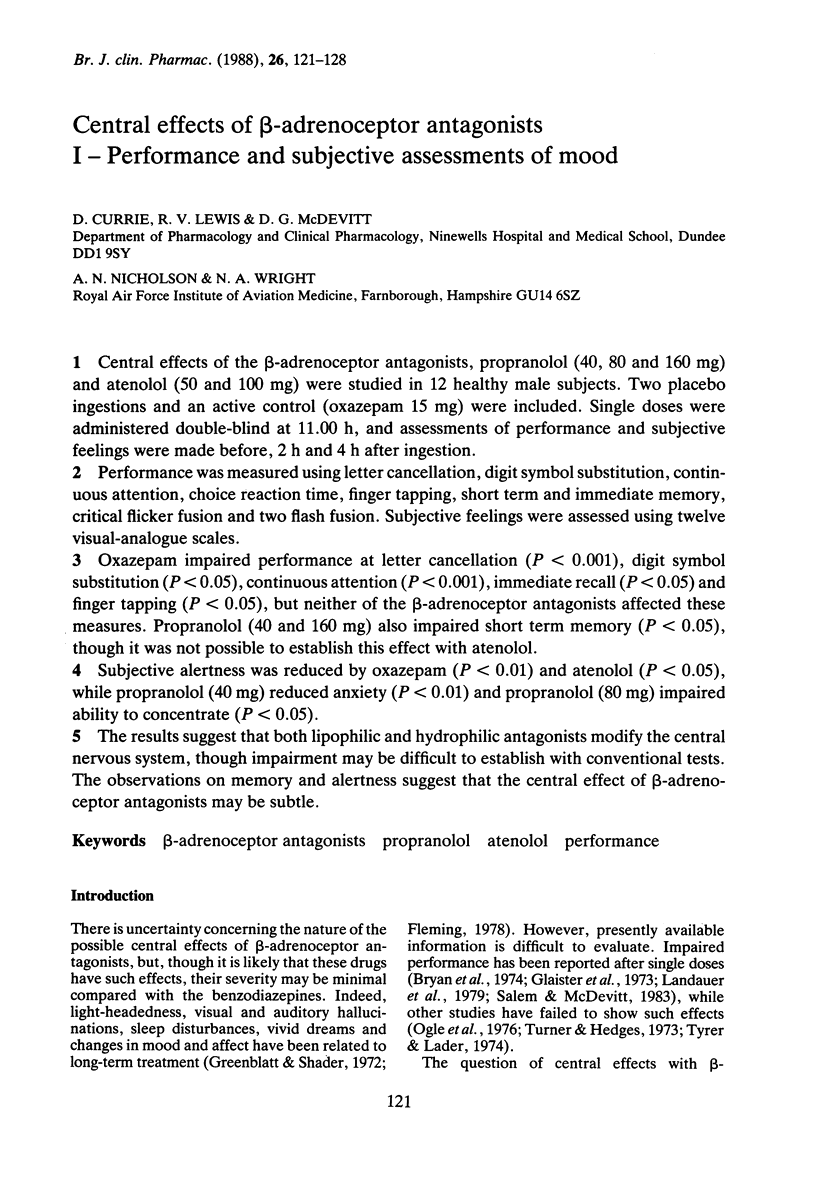
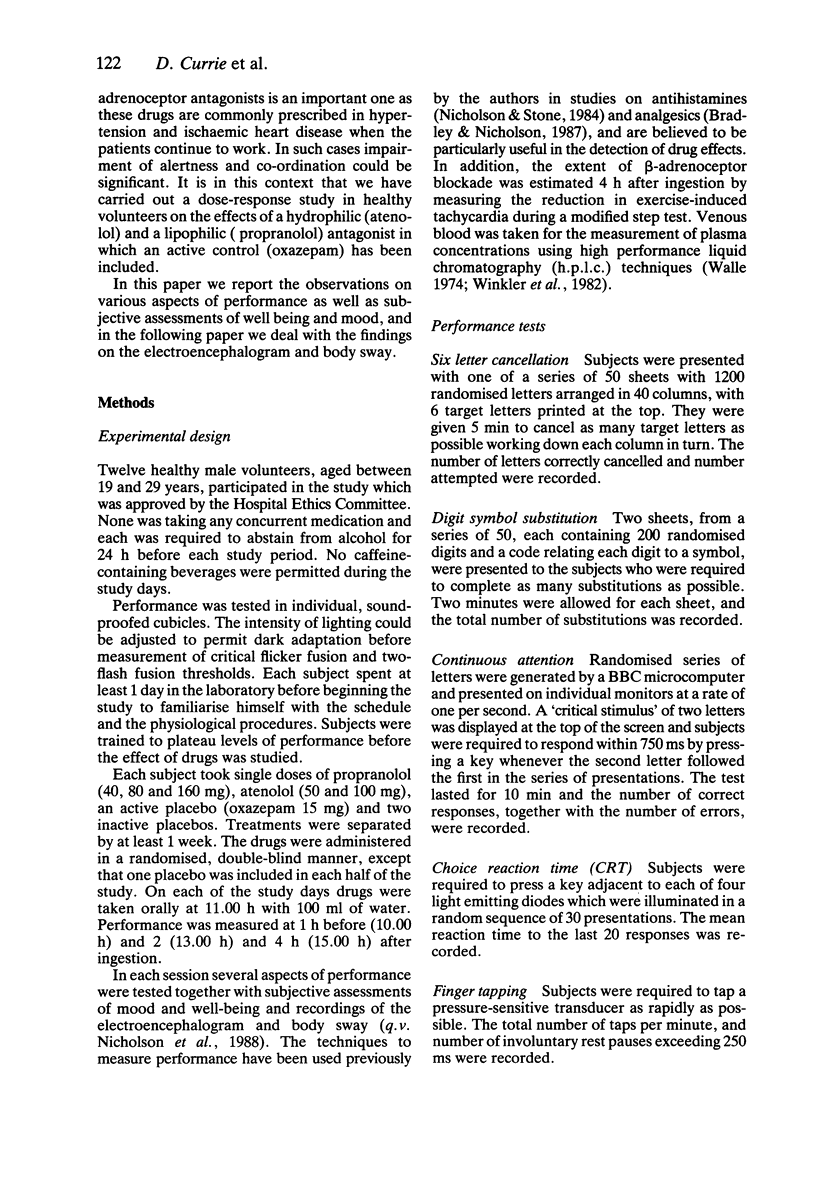
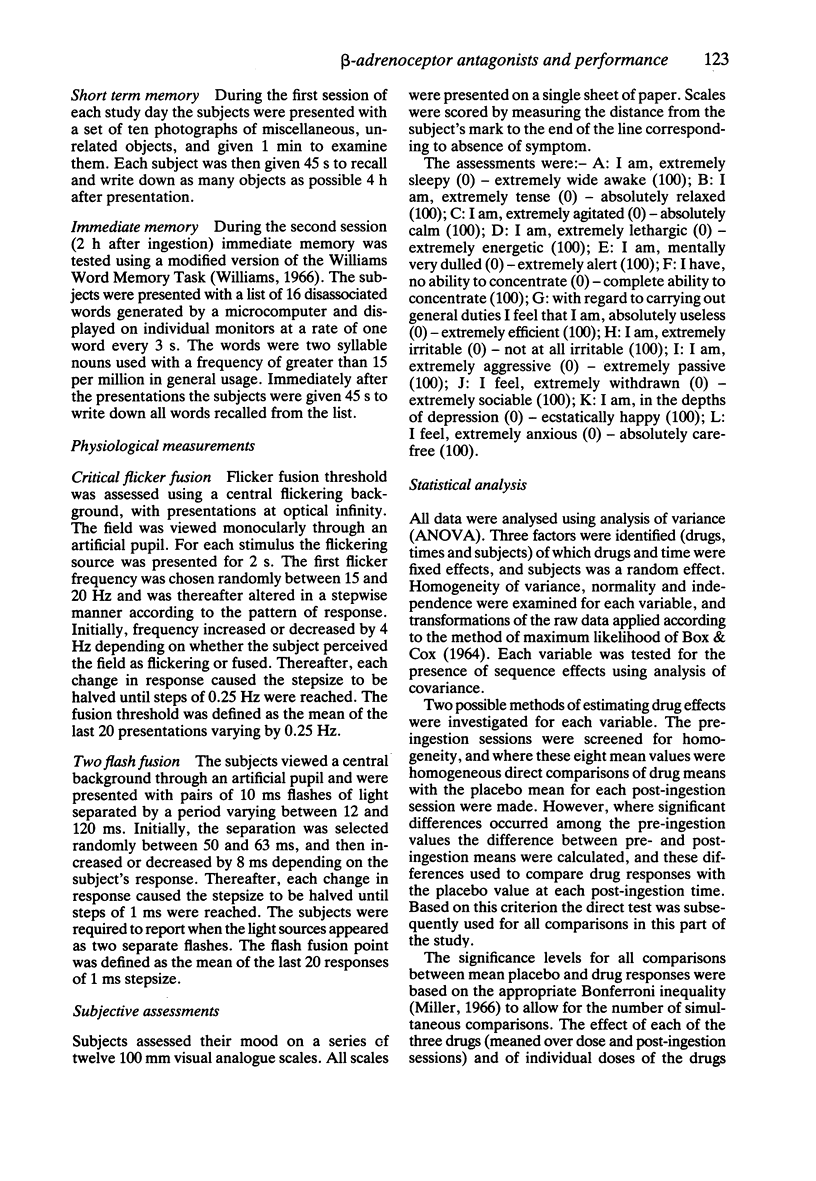
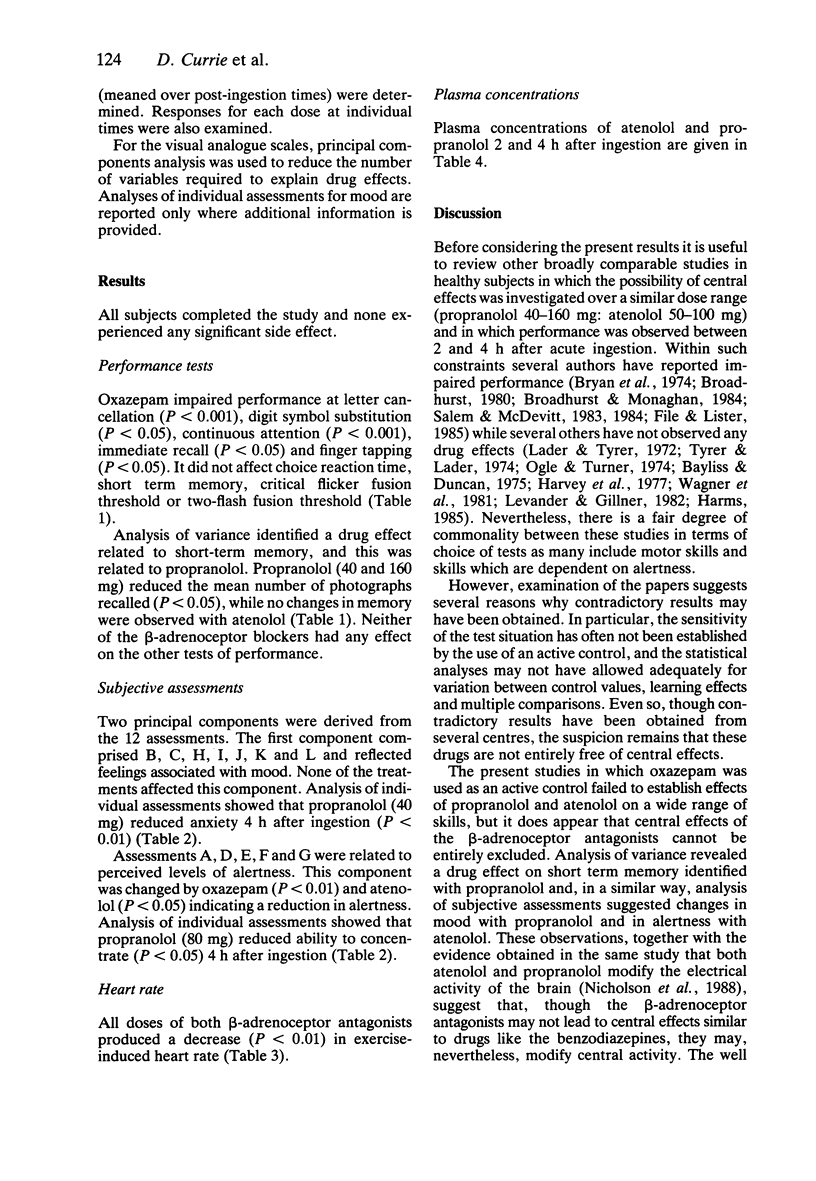
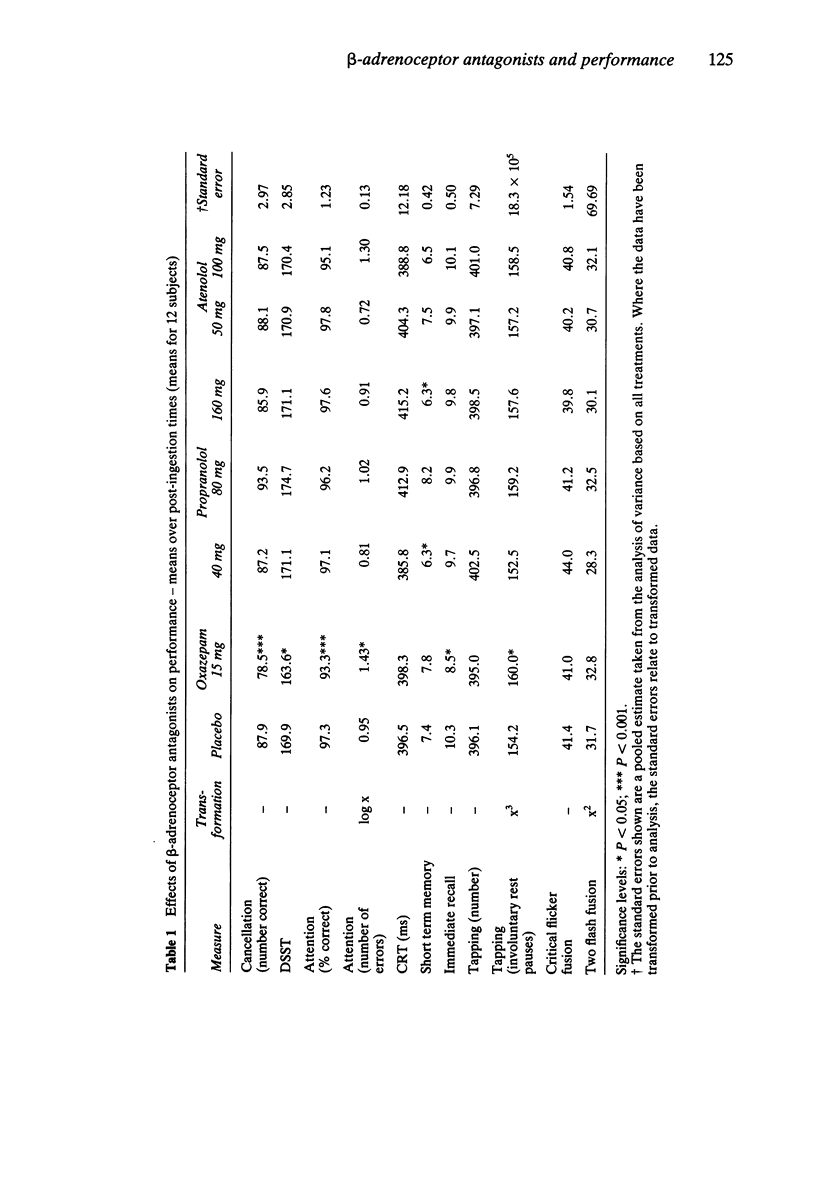
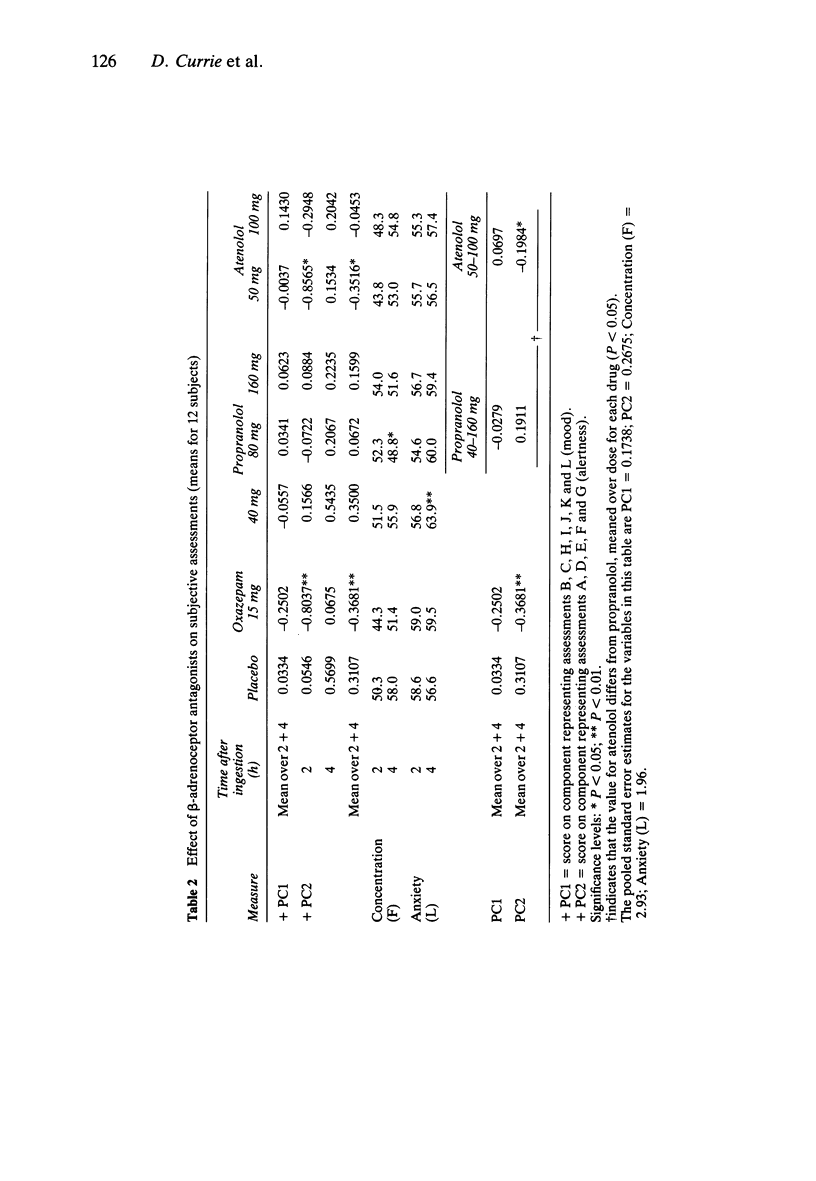
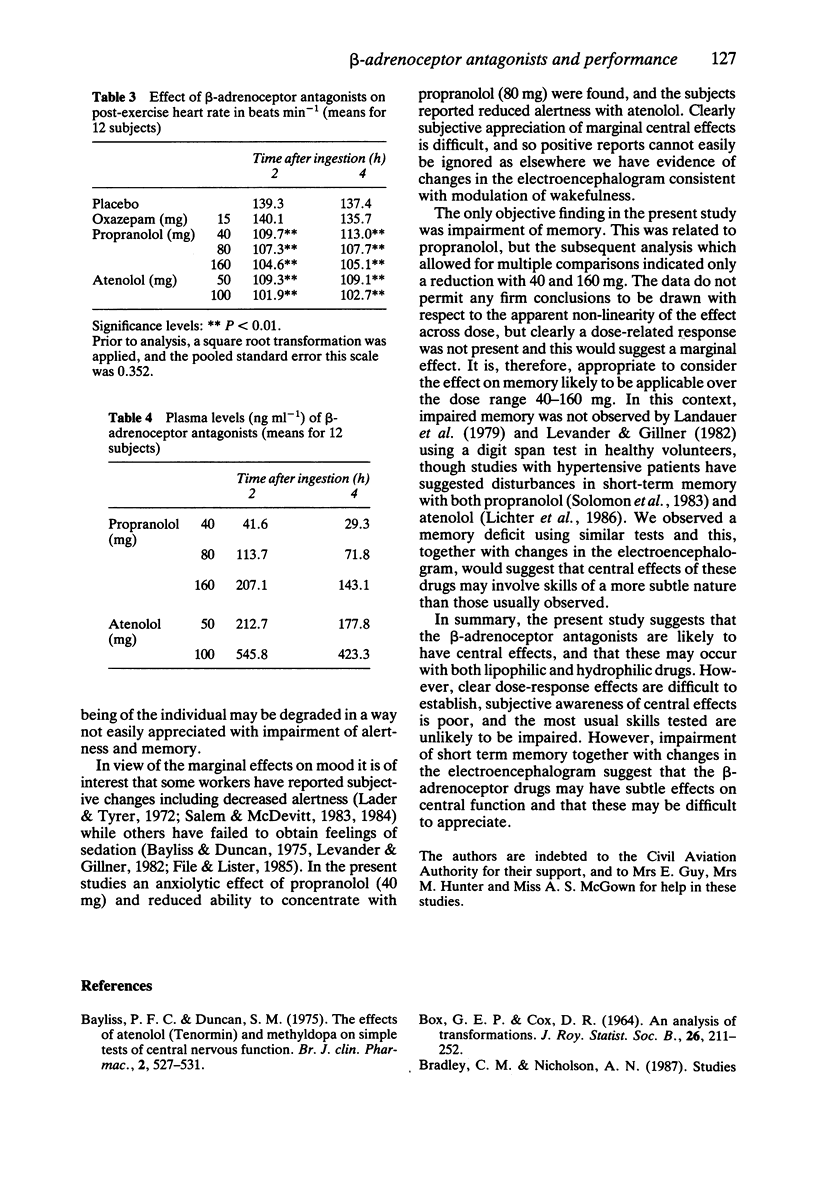
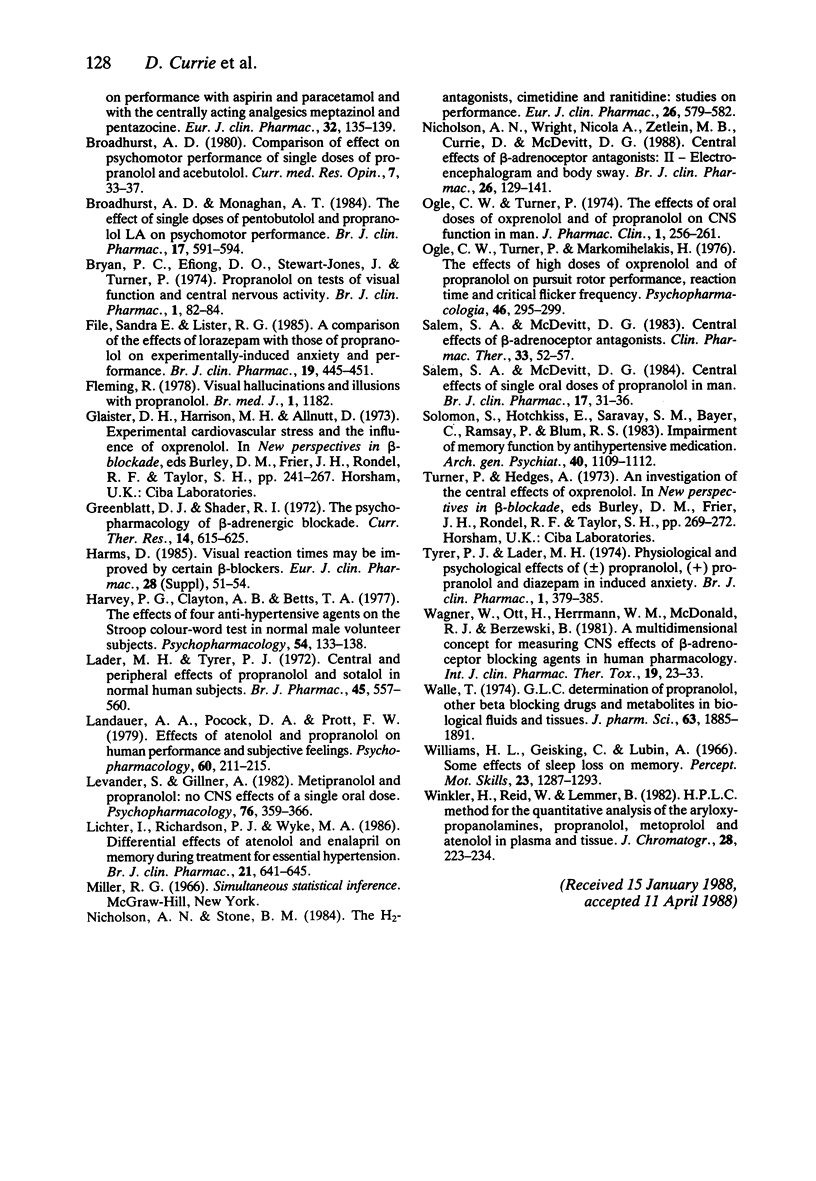
Selected References
These references are in PubMed. This may not be the complete list of references from this article.
- Bayliss P. F., Duncan S. M. The effects of atenolol (tenormin) and methyldopa on simple tests of central nervous function. Br J Clin Pharmacol. 1975 Dec;2(6):527–531. doi: 10.1111/j.1365-2125.1975.tb00571.x. [DOI] [PMC free article] [PubMed] [Google Scholar]
- Bradley C. M., Nicholson A. N. Studies on performance with aspirin and paracetamol and with the centrally acting analgesics meptazinol and pentazocine. Eur J Clin Pharmacol. 1987;32(2):135–139. doi: 10.1007/BF00542185. [DOI] [PubMed] [Google Scholar]
- Broadhurst A. D. Comparison of effect on psychomotor performance of single doses of propranolol and acebutolol. Curr Med Res Opin. 1980;7(1):33–37. doi: 10.1185/03007998009116512. [DOI] [PubMed] [Google Scholar]
- Broadhurst A. D., Monaghan A. T. The effect of single doses of penbutolol and propranolol L.A. on psychomotor performance. Br J Clin Pharmacol. 1984 May;17(5):591–594. doi: 10.1111/j.1365-2125.1984.tb02396.x. [DOI] [PMC free article] [PubMed] [Google Scholar]
- Fleminger R. Visual hallucinations and illusions with propranolol. Br Med J. 1978 May 6;1(6121):1182–1182. doi: 10.1136/bmj.1.6121.1182. [DOI] [PMC free article] [PubMed] [Google Scholar]
- Greenblatt D. J., Shader R. I. On the psychopharmacology of beta adrenergic blockade. Curr Ther Res Clin Exp. 1972 Sep;14(9):615–625. [PubMed] [Google Scholar]
- Harms D. Visual reaction times may be improved by certain beta-blockers. Eur J Clin Pharmacol. 1985;28 (Suppl):51–54. doi: 10.1007/BF00543710. [DOI] [PubMed] [Google Scholar]
- Harvey P. G., Clayton A. B., Betts T. A. The effects of four antihypertensive agents on the Stroop colour-word test in normal male volunteer subjects. Psychopharmacology (Berl) 1977 Oct 20;54(2):133–138. doi: 10.1007/BF00426768. [DOI] [PubMed] [Google Scholar]
- Lader M. H., Tyrer P. J. Central and peripheral effects of propranolol and sotalol in normal human subjects. Br J Pharmacol. 1972 Jul;45(3):557–560. doi: 10.1111/j.1476-5381.1972.tb08113.x. [DOI] [PMC free article] [PubMed] [Google Scholar]
- Landauer A. A., Pocock D. A., Prott F. W. Effects of atenolol and propranolol on human performance and subjective feelings. Psychopharmacology (Berl) 1979 Jan 31;60(2):211–215. doi: 10.1007/BF00432296. [DOI] [PubMed] [Google Scholar]
- Levander S., Gillner A. Metipranolol and propranolol: no CNS effects of a single oral dose. Psychopharmacology (Berl) 1982;76(4):359–366. doi: 10.1007/BF00449125. [DOI] [PubMed] [Google Scholar]
- Lichter I., Richardson P. J., Wyke M. A. Differential effects of atenolol and enalapril on memory during treatment for essential hypertension. Br J Clin Pharmacol. 1986 Jun;21(6):641–645. doi: 10.1111/j.1365-2125.1986.tb05228.x. [DOI] [PMC free article] [PubMed] [Google Scholar]
- Nicholson A. N., Stone B. M. The H2-antagonists, cimetidine and ranitidine: studies on performance. Eur J Clin Pharmacol. 1984;26(5):579–582. doi: 10.1007/BF00543488. [DOI] [PubMed] [Google Scholar]
- Nicholson A. N., Wright N. A., Zetlein M. B., Currie D., McDevitt D. G. Central effects of beta-adrenoceptor antagonists. II--Electroencephalogram and body sway. Br J Clin Pharmacol. 1988 Aug;26(2):129–141. doi: 10.1111/j.1365-2125.1988.tb03379.x. [DOI] [PMC free article] [PubMed] [Google Scholar]
- Ogle C. W., Turner P., Markomihelakis H. The effects of high doses of oxprenolol and of propranolol on pursuit rotor performance, reaction time and critical flicker frequency. Psychopharmacologia. 1976 Apr 15;46(3):295–299. doi: 10.1007/BF00421117. [DOI] [PubMed] [Google Scholar]
- Salem S. A., McDevitt D. G. Central effects of beta-adrenoceptor antagonists. Clin Pharmacol Ther. 1983 Jan;33(1):52–57. doi: 10.1038/clpt.1983.7. [DOI] [PubMed] [Google Scholar]
- Salem S. A., McDevitt D. G. Central effects of single oral doses of propranolol in man. Br J Clin Pharmacol. 1984 Jan;17(1):31–36. doi: 10.1111/j.1365-2125.1984.tb04995.x. [DOI] [PMC free article] [PubMed] [Google Scholar]
- Solomon S., Hotchkiss E., Saravay S. M., Bayer C., Ramsey P., Blum R. S. Impairment of memory function by antihypertensive medication. Arch Gen Psychiatry. 1983 Oct;40(10):1109–1112. doi: 10.1001/archpsyc.1983.01790090071011. [DOI] [PubMed] [Google Scholar]
- Wagner W., Ott H., Herrmann W. M., McDonald R. J., Berzewski B. A multidimensional concept for measuring CNS effects of beta-adrenoceptor blocking agents in human pharmacology. Int J Clin Pharmacol Ther Toxicol. 1981 Jan;19(1):23–33. [PubMed] [Google Scholar]
- Walle T. GLC determination of propranolol, other beta-blocking drugs, and metabolites in biological fluids and tissues. J Pharm Sci. 1974 Dec;63(12):1885–1891. doi: 10.1002/jps.2600631212. [DOI] [PubMed] [Google Scholar]
- Williams H. L., Gieseking C. F., Lubin A. Some effects of sleep loss on memory. Percept Mot Skills. 1966 Dec;23(3):1287–1293. doi: 10.2466/pms.1966.23.3f.1287. [DOI] [PubMed] [Google Scholar]
- Winkler H., Ried W., Lemmer B. High-performance liquid chromatographic method for the quantitative analysis of the aryloxypropanolamines propranolol, metoprolol and atenolol in plasma and tissue. J Chromatogr. 1982 Mar 12;228:223–234. doi: 10.1016/s0378-4347(00)80435-1. [DOI] [PubMed] [Google Scholar]


